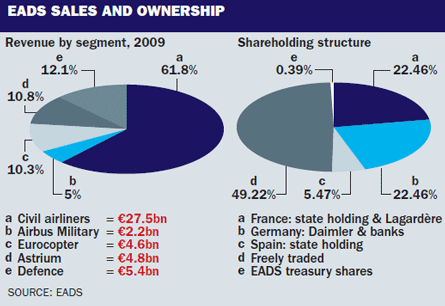Do not expect any surprises when EADS publishes its 2010 results this week. The announcement, to be spelled out in detail in Munich, will feel like the third or so time the figures have been laid out since the group and its divisions made their traditional January state-of-the-company briefings in Paris.
Chief executive Louis Gallois, and Francois Auque and Lutz Bertling, who head the Astrium space and Eurocopter rotorcraft divisions, have given a broad-brush picture of last year’s performance: total group revenue of about €44 billion ($60.8 billion), on a par with 2009’s €44.5 billion, and profit – earnings before interest and taxes (EBIT) – at what Gallois admitted was an unsatisfactory €1.1 billion, a figure expected to be repeated in 2011 before profitability finally gains altitude in 2012.
We also know that Astrium, the satellites-to-Ariane-rockets space division, made revenue close to €5 billion (up 4% on 2009) while Eurocopter was up 6% at €4.8 billion and, according to Bertling, made a profit “not below” the EADS average – which points to about €120 million (compared with €263 million EBIT posted for 2009).
What we do not know for certain is revenue and profit from the other three reporting units: Airbus civil, Airbus Military and the recently renamed Cassidian defence and security division. But a storming year by Airbus civil – the company delivered an all-time record 510 airliners last year and took net orders for 574 to help EADS build a whopping €10 billion cash pile – combined with the static total group revenue points to a downturn at Cassidian and Airbus Military, with its troubled A400M programme.

One thing for sure is that Gallois, finance director Hans Peter Ring and their EADS board colleagues will have to field some difficult questions about EADS’s “Vision 2020” plan to grow away from the imbalanced business dominated by Airbus.
In 2009 civil airliners – Airbus plus EADS’s share of ATR – accounted for 62% of EADS’s revenue, and given Airbus’s record performance last year it is hard to see how that ratio will not have moved even further from the 50-50 balance sought by 2020.
Going forward, the balance challenge gets harder.
The A380 superjumbo has been a drain but may become a winner; the Boeing 747 was launched in 1966 but did not hit its sales peak for 25 years. The A350 XWB widebody, successor to the A330, is set to enter service in 2013.
The other question Gallois and his colleagues may face concerns the ownership of EADS.
Apart from being the parent of Airbus, EADS is probably best known as the company that, having been created by a merger of national aerospace champions, remains the subject of much politicking between Paris and Berlin, both of which are determined to maintain an equal workshare.
By agreement each holds, through proxies, 22.46% of the shares. However, those proxies – France’s Lagardère and Germany’s Daimler – are showing signs they want out. Market chatter has Daimler, in particular, anxious to focus on its core automobile business and find another owner for perhaps half of its 15% EADS stake.
A buyer is also needed in the next year or so for another 7.46% that a consortium of German banks agreed some time ago to buy from Daimler and hold temporarily.Gallois will say the matter is one for shareholders, not management.
Daimler finance chief and EADS chairman Bodo Uebber says that Daimler, whose former aerospace division is a keystone of EADS’s capabilities, intends to retain “industrial leadership” of the German interest.
Royal Bank of Scotland equities analyst Sandy Morris reckons nothing will happen until at least mid-2012, when it will start to be clear whether the A350 is on schedule. Before then any significant sale by a major shareholder would be “an unusual step”.
He questions why Berlin and Paris are obsessed with balance of ownership, and he may be right in suggesting national interests would be best served by giving investors what they really want – most shares to be freely traded. Gallois has this year talked about developing North American and Asian “pillars” to balance EADS’s European presence, but stresses: “No company can survive without roots.” And, he adds, for EADS the roots are in Europe.
Source: FlightGlobal.com
















